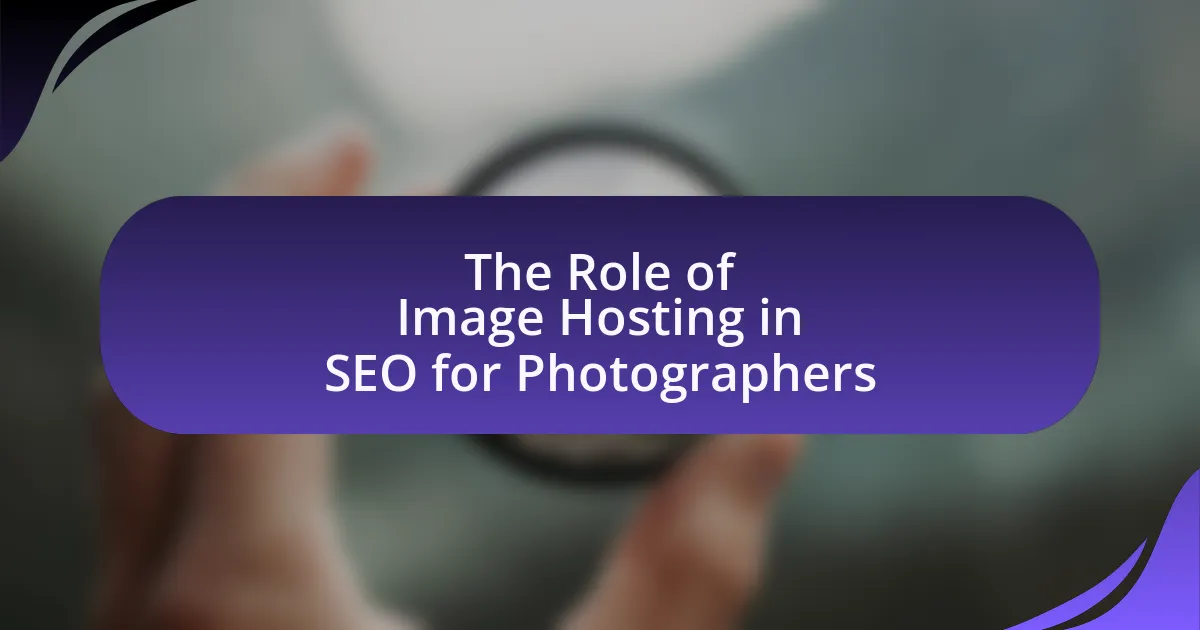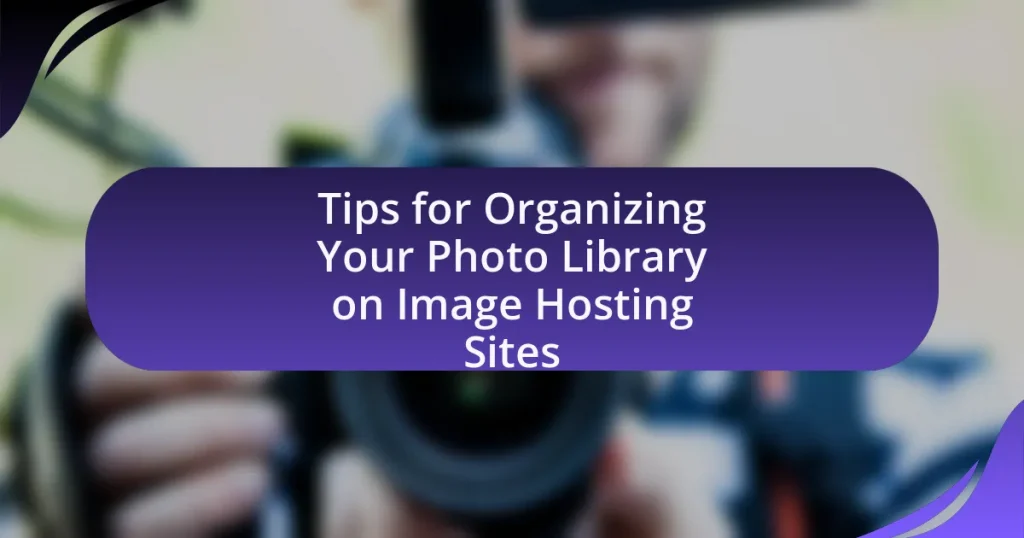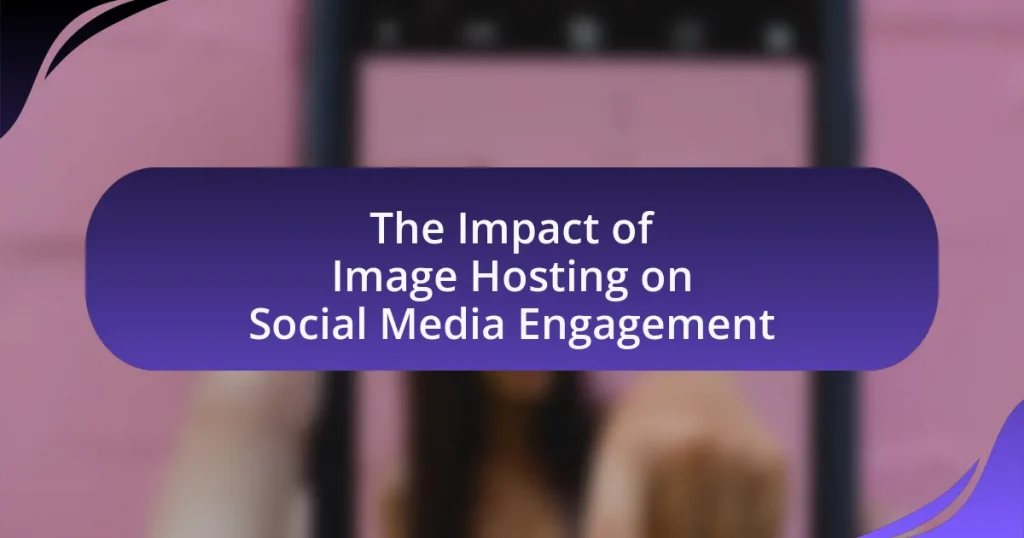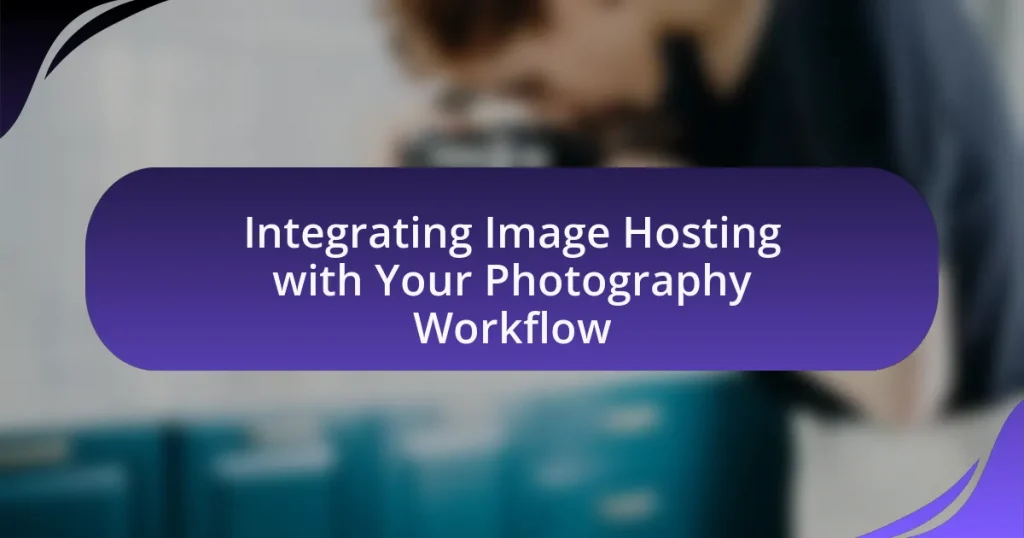The article focuses on the critical role of image hosting in search engine optimization (SEO) for photographers. It outlines how effective image hosting enhances website loading speed, improves user experience, and facilitates the implementation of SEO best practices, such as using descriptive file names and alt text. Key factors influencing SEO, including image file size, format, and quality, are discussed, along with the advantages of specialized image hosting services over traditional hosting. The article also addresses common challenges photographers face with image hosting and provides best practices for optimizing images to improve online visibility and search engine rankings.
What is the Role of Image Hosting in SEO for Photographers?
Image hosting plays a crucial role in SEO for photographers by optimizing the visibility and loading speed of their images on search engines. When photographers use reliable image hosting services, they ensure that their images are served quickly to users, which enhances user experience and reduces bounce rates. Faster loading times are a significant ranking factor for search engines like Google, as they prioritize websites that provide a seamless experience.
Additionally, image hosting platforms often provide tools for image optimization, such as automatic resizing and compression, which help maintain image quality while reducing file size. This optimization is essential because search engines favor websites that load efficiently. Furthermore, proper image hosting allows photographers to implement SEO best practices, such as using descriptive file names and alt text, which improve the chances of images appearing in search results and image searches.
In summary, effective image hosting directly impacts a photographer’s SEO strategy by improving site speed, enabling optimization features, and facilitating the use of SEO techniques that enhance image discoverability.
How does image hosting impact a photographer’s online visibility?
Image hosting significantly enhances a photographer’s online visibility by improving website loading speed and search engine optimization (SEO). Fast-loading images contribute to a better user experience, which is a critical factor for search engine rankings. According to Google, page speed is a ranking factor, meaning that websites with optimized image hosting can achieve higher visibility in search results. Additionally, image hosting platforms often provide tools for SEO, such as alt text and metadata management, which further enhance discoverability. This combination of speed and SEO optimization leads to increased traffic and engagement, ultimately boosting a photographer’s online presence.
What are the key factors of image hosting that influence SEO?
The key factors of image hosting that influence SEO include image file size, image format, alt text, and hosting speed. Image file size affects loading times; smaller files enhance page speed, which is a ranking factor for search engines. Image format, such as JPEG or PNG, can impact quality and loading speed, with JPEG often being preferred for photographs due to its balance of quality and compression. Alt text provides context to search engines about the image content, improving accessibility and indexing. Lastly, hosting speed, determined by the server’s performance, directly influences overall site speed, which is critical for user experience and SEO rankings.
How does image quality affect search engine rankings?
Image quality significantly impacts search engine rankings by influencing user engagement and site performance metrics. High-quality images enhance user experience, leading to longer page visits and lower bounce rates, which are positive signals to search engines like Google. Additionally, search engines prioritize websites that load quickly; optimized images contribute to faster loading times, further improving rankings. Research indicates that 47% of consumers expect a web page to load in two seconds or less, and a one-second delay can lead to a 7% reduction in conversions. Therefore, maintaining high image quality while ensuring optimization is crucial for improving search engine visibility.
Why is image hosting essential for photographers?
Image hosting is essential for photographers because it provides a reliable platform for storing, sharing, and showcasing their work. This reliability ensures that high-quality images are accessible to potential clients and audiences without compromising load times or image quality. Furthermore, effective image hosting can enhance a photographer’s online visibility, as optimized images can improve search engine rankings. According to a study by Moz, page load speed is a ranking factor for Google, meaning that faster-loading images can lead to better SEO performance. Thus, image hosting not only preserves the integrity of a photographer’s portfolio but also plays a crucial role in their overall online marketing strategy.
What advantages does image hosting provide over traditional hosting?
Image hosting offers several advantages over traditional hosting, primarily in terms of performance, scalability, and ease of use. Image hosting services are optimized for storing and delivering images, which results in faster loading times and improved website performance. This is crucial for SEO, as search engines prioritize page speed in their ranking algorithms. Additionally, image hosting platforms often provide automatic image optimization features, such as compression and resizing, which enhance user experience and reduce bandwidth usage. Furthermore, these services typically offer scalable storage solutions, allowing photographers to easily manage large volumes of images without the limitations often encountered with traditional hosting.
How does image hosting enhance website performance?
Image hosting enhances website performance by offloading the storage and delivery of images to specialized servers, which improves loading speed and reduces bandwidth usage. Faster loading times lead to better user experience and lower bounce rates, as studies show that a one-second delay in page load time can decrease conversions by 7%. Additionally, image hosting services often utilize content delivery networks (CDNs) that distribute images across multiple locations, ensuring quicker access for users regardless of their geographic location. This optimization not only boosts website performance but also positively impacts search engine rankings, as search engines prioritize fast-loading sites.
What are the best practices for image hosting in SEO?
The best practices for image hosting in SEO include optimizing image file names, using descriptive alt text, compressing images for faster loading times, and ensuring mobile responsiveness. Optimizing file names with relevant keywords helps search engines understand the content of the image, while descriptive alt text improves accessibility and provides context for search engines. Compressing images reduces their file size, which enhances page load speed, a critical factor for SEO rankings. Additionally, ensuring that images are responsive allows them to display correctly on various devices, improving user experience and engagement. These practices collectively contribute to better visibility in search engine results and enhance overall website performance.
How can photographers optimize their images for search engines?
Photographers can optimize their images for search engines by using descriptive file names, alt text, and appropriate image formats. Descriptive file names should include relevant keywords that accurately represent the image content, enhancing search visibility. Alt text provides context to search engines and visually impaired users, improving accessibility and SEO; it should be concise yet descriptive, ideally incorporating keywords. Additionally, using the right image formats, such as JPEG for photographs and PNG for graphics, ensures a balance between quality and loading speed, which is crucial for user experience and search rankings. According to Google, page speed is a ranking factor, making image optimization essential for better search engine performance.
What file formats are best for SEO and why?
The best file formats for SEO are JPEG, PNG, and GIF. JPEG is preferred for photographs due to its balance of quality and file size, which enhances loading speed—a critical factor for SEO. PNG is ideal for images requiring transparency and high quality, making it suitable for logos and graphics. GIF is useful for simple animations and small graphics, but its limited color palette can affect image quality. Using these formats correctly can improve user experience and site performance, both of which are essential for better search engine rankings.
How does image size affect loading times and SEO?
Image size significantly affects loading times and SEO performance. Larger images increase the time it takes for a webpage to load, which can lead to higher bounce rates; studies show that a one-second delay in loading time can reduce conversions by 7%. Search engines like Google consider page speed as a ranking factor, meaning slower-loading pages may rank lower in search results. Optimizing image size through compression and appropriate formats can enhance loading speeds, thereby improving user experience and SEO rankings.
What role do alt tags play in image SEO?
Alt tags play a crucial role in image SEO by providing descriptive text for images, which helps search engines understand the content of the images. This descriptive text enhances accessibility for visually impaired users and improves the chances of images appearing in search results, thereby driving more traffic to the website. According to Google’s SEO guidelines, using relevant keywords in alt tags can positively influence image rankings in search results, as search engines rely on this text to index images accurately.
How should photographers write effective alt tags?
Photographers should write effective alt tags by clearly describing the content and function of the image in a concise manner. An effective alt tag typically includes relevant keywords that reflect the image’s subject, context, and purpose, which helps improve search engine optimization (SEO). For instance, instead of using generic phrases like “image” or “photo,” a photographer might use “sunset over the Grand Canyon” to provide specific information. This practice not only aids visually impaired users in understanding the image but also enhances the image’s discoverability in search engines, as alt text is indexed by search algorithms. Studies show that images with descriptive alt tags can rank higher in search results, thereby increasing visibility and traffic to a photographer’s website.
What common mistakes should be avoided when using alt tags?
Common mistakes to avoid when using alt tags include using generic descriptions, omitting alt tags altogether, and stuffing keywords. Generic descriptions like “image” or “photo” do not provide meaningful context for visually impaired users or search engines. Omitting alt tags entirely results in lost opportunities for accessibility and SEO benefits, as search engines rely on these tags to understand image content. Keyword stuffing, or overloading alt tags with keywords, can lead to penalties from search engines and diminish user experience. Properly crafted alt tags should be descriptive, concise, and relevant to the image content, enhancing both accessibility and SEO.
What are the common challenges photographers face with image hosting?
Photographers commonly face challenges with image hosting, including limited storage capacity, slow loading times, and inadequate security measures. Limited storage can restrict the number of images a photographer can upload, impacting their ability to showcase their portfolio effectively. Slow loading times can lead to poor user experience and negatively affect search engine rankings, as page speed is a critical factor in SEO. Inadequate security measures can expose photographers to risks such as unauthorized access or image theft, which can undermine their intellectual property rights. These challenges highlight the importance of selecting a reliable image hosting service that addresses these specific needs.
How can photographers troubleshoot image hosting issues?
Photographers can troubleshoot image hosting issues by systematically checking their internet connection, verifying the image file formats supported by the hosting service, and ensuring that the images are not exceeding the size limits set by the host. A stable internet connection is crucial, as interruptions can prevent images from uploading or displaying correctly. Additionally, most hosting services support common formats like JPEG and PNG, so photographers should confirm that their images are in these formats. Lastly, many hosting platforms impose size restrictions, often around 2MB per image; exceeding this limit can lead to upload failures or slow loading times. By addressing these factors, photographers can effectively resolve common image hosting problems.
What are the signs of poor image hosting affecting SEO?
Signs of poor image hosting affecting SEO include slow loading times, broken image links, and lack of proper image optimization. Slow loading times can lead to higher bounce rates, as users are less likely to wait for images to load, negatively impacting search rankings. Broken image links result in a poor user experience and can lead to lower site credibility, which search engines consider when ranking pages. Additionally, images that are not optimized for size and format can increase page load times and reduce overall site performance, further harming SEO efforts.
How can photographers ensure their images are properly indexed by search engines?
Photographers can ensure their images are properly indexed by search engines by using descriptive file names, alt text, and structured data. Descriptive file names should include relevant keywords that accurately represent the image content, which helps search engines understand the context. Alt text should provide a clear description of the image, as search engines use this text to index images and improve accessibility for visually impaired users. Additionally, implementing structured data, such as schema markup, can enhance how images are displayed in search results, making them more likely to be indexed correctly. These practices are supported by SEO guidelines from sources like Google, which emphasize the importance of optimizing images for better search visibility.
What tools can photographers use to enhance their image hosting strategy?
Photographers can enhance their image hosting strategy by utilizing platforms such as SmugMug, Flickr, and Adobe Portfolio. These tools provide features like customizable galleries, SEO optimization options, and integration with social media, which are essential for improving visibility and engagement. For instance, SmugMug offers built-in SEO tools that help photographers optimize their images for search engines, while Flickr allows for community engagement through sharing and commenting, increasing exposure. Adobe Portfolio enables seamless integration with Adobe Creative Cloud, streamlining the workflow for photographers and enhancing their online presence.
Which analytics tools help track image performance in SEO?
Google Analytics is a primary tool that helps track image performance in SEO. It allows users to analyze traffic sources, user behavior, and engagement metrics related to images on their websites. Additionally, Google Search Console provides insights into how images are indexed and their visibility in search results, including impressions and click-through rates. Tools like SEMrush and Ahrefs also offer image performance tracking features, enabling users to assess image optimization and its impact on overall SEO rankings. These tools collectively provide comprehensive data that supports effective image SEO strategies.
How can photographers leverage social media for better image hosting results?
Photographers can leverage social media by using platforms like Instagram and Pinterest to showcase their images, which increases visibility and drives traffic to their image hosting sites. By sharing high-quality images and engaging content, photographers can attract followers who are likely to share their work, thereby enhancing reach. According to a study by HubSpot, posts with images receive 94% more views than those without, highlighting the effectiveness of visual content in social media engagement. Additionally, utilizing relevant hashtags and participating in photography communities can improve discoverability, leading to better image hosting results.
What are the top tips for photographers to improve their image hosting for SEO?
To improve image hosting for SEO, photographers should focus on optimizing image file names, using descriptive alt text, and ensuring fast loading times. Optimizing image file names by including relevant keywords helps search engines understand the content of the images. Descriptive alt text not only improves accessibility but also provides context for search engines, enhancing the chances of appearing in image searches. Additionally, using a reliable hosting service that minimizes loading times is crucial, as page speed is a ranking factor for search engines; studies show that a one-second delay in loading can lead to a 7% reduction in conversions.



